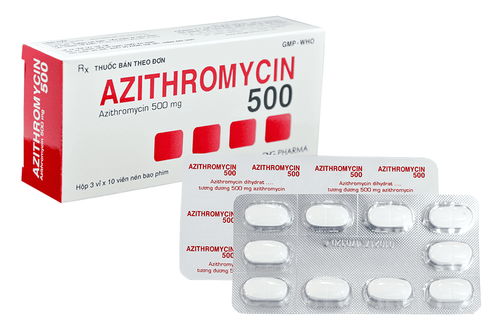This is an automatically translated article.
Auromitaz is prepared in the form of a powder for injection with the main ingredient being Ceftazidime. The drug is used in the treatment of certain infections.
1. What does Auromitaz 100 do?
What are the uses of Auromitaz 100? The drug has the main ingredient is 1g Ceftazidime (in the form of Ceftazidime pentahydrate and buffered sodium carbonate). Ceftazidime is a 3rd generation cephalosporin antibiotic.
Ceftazidime has a bactericidal effect due to the inhibition of bacterial cell wall synthesis enzymes. Ceftazidime is stable to most bacterial beta-lactamases, with the exception of bacteroides enzymes. Auromitaz is sensitive to ampicillin-resistant gram-positive bacteria, many gram-negative organisms that are resistant to aminoglycosides and other cephalosporins.
Indications: Drug Auromitaz 100 is used in the following cases:
Treatment of lower respiratory tract infections; Treatment of skin and skin structure infections; Treatment of joint and bone infections; Treatment of gynecological infections; Treatment of intra-abdominal infections; Treatment of central nervous system infections (including meningitis). Contraindications: Do not use Auromitaz in the following cases:
Patients with a history of shock when using the drug; Hypersensitivity to cephalosporin antibiotics.
2. How to use and dose Auromitaz 100
How to use:
Use Auromitaz 100 by deep intramuscular injection or intravenous infusion: Usually injected into the upper quadrant of the buttocks or the lateral part of the thigh; Instructions for mixing solution for infusion: Solution for intramuscular injection: Mix Ceftazidime 1g in 3ml of distilled water for injection or 1% or 0.5% lidocaine hydrochloride solution; Intravenous solution: Mix Ceftazidime 1g in 10ml distilled water for injection or 5% dextrose solution or 0.9% sodium chloride solution; Solution for infusion: Mix the drug in similar solutions for intravenous injection but with a concentration of 10 - 20 mg/ml (1 - 2g of drug in 100ml of solvent). Dosage:
The usual dose for adults is 1g x 8 hours/time or 2g x 12 hours/time, intravenous infusion or deep intramuscular injection; Patients with hepatic impairment: There is no need to adjust the dose of Auromitaz in patients with impaired liver function; Patients with renal impairment: Dosage adjustment of Auromitaz is required. The recommended dosage of Ceftazidime in patients with renal failure is as follows: Creatinine clearance 31 - 0 ml/min: Take 1g x 12 hours/time; Creatinine clearance 16 - 30 ml/min: Use 1g x 24 hours/time; Creatinine clearance 6 - 15ml/min: Use 0.5g x 24 hours/time; Creatinine clearance < 5ml/min: Use 0.5g x 48 hours/time; Children: Dosage for pediatric patients is prescribed by a doctor or recommended as follows: Infants from 0 to 4 weeks old: Use a dose of 30mg/kg intravenously x 12 hours/time; Children from 1 month to 12 years old: Use a dose of 30 - 50mg/kg intravenously, up to 6g/day x 8 hours/time; Elderly: The usual dose of Auromitaz should not exceed 3g/day, especially in patients over 70 years of age. When using Auromitaz 100, patients need to remember to take the drug regularly to avoid forgetting doses. If you accidentally miss a dose, you should absolutely not take a double dose at the next dose because this can cause many unpredictable risks. Please consult your treating physician in case of missed dose or overdose of Auromitaz for guidance on appropriate management.
3. Side effects of Auromitaz 100
There may be unwanted side effects when using Auromitaz 100 with local manifestations such as: hypersensitivity, itching rash, swelling at the injection site, diarrhea, vomiting, nausea, abdominal pain. If you experience serious side effects while taking Auromitaz, you should notify your treating doctor for timely instructions.
4. Be careful when using Auromitaz 100
Some things patients need to keep in mind before and while using Auromitaz 100:
Care should be taken when using the drug for people with a history of hypersensitivity to Ceftazidime, penicillins and cephalosporins; There is a risk of cross-reactivity between cephalosporins and penicillins; Patients using Auromitaz may develop pseudomembranous colitis; The total daily dose of Auromitaz should be reduced in patients with renal impairment; High concentrations of Auromitaz can cause encephalopathy, convulsions, loss of balance or neuromuscular excitability; Treatment with Ceftazidime may reduce prothrombin activity in patients with renal, hepatic or malnourished patients; Use caution when using Auromitaz 100 in patients with a history of gastrointestinal disease, dysentery; Cephalosporins are considered safe for babies during pregnancy. However, there are still no satisfactory and closely controlled studies in pregnant women, so Auromitaz should be used during pregnancy only if absolutely necessary; Ceftazidime is excreted in milk. Therefore, consideration should be given to the use of Auromitaz in women who are breast-feeding. During the use of Auromitaz 100, patients should strictly follow the instructions from the treating doctor. To avoid the risk of drug interactions, patients need to share with their doctor about the drugs they are taking, the diseases they have / are suffering from. Patients are also absolutely not allowed to arbitrarily stop the drug, change the dose of the drug, ... without the permission of the doctor.
Follow Vinmec International General Hospital website to get more health, nutrition and beauty information to protect the health of yourself and your loved ones in your family.













